UC Davis Researchers Elevate the Prestige of Olives and Olive Oil
INSIDE ACADEMIA
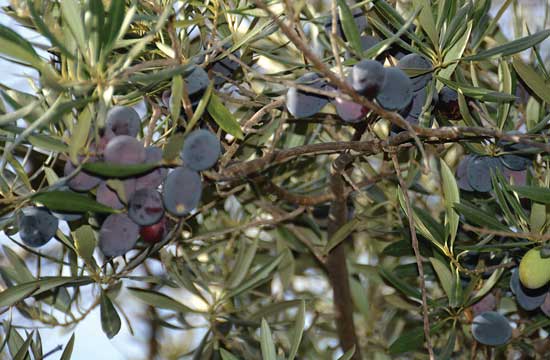 Every day health-conscious consumers around the country visit grocery stores and high-end markets in search of one of nature’s finest nectars: extra virgin olive oil. In their quest for the perfect oil, they peruse supermarket shelves lined with countless bottles and tins with attractive labels depicting pristine groves of olive trees in Italy, Greece, or Spain. The labels often include phrases such as “imported from Greece,” “bottled in Italy,” and “made with fine Spanish olives.” Phrases such as these along with brand recognition, price points, color, and value are the characteristics consumers typically use to determine whether a brand of extra virgin olive oil is of good quality and worth purchasing to stock their pantries and kitchen cabinets. However, according to researchers at the University of California, Davis (UC Davis), Olive Center, none of these attributes indicates good extra virgin olive oil.
Every day health-conscious consumers around the country visit grocery stores and high-end markets in search of one of nature’s finest nectars: extra virgin olive oil. In their quest for the perfect oil, they peruse supermarket shelves lined with countless bottles and tins with attractive labels depicting pristine groves of olive trees in Italy, Greece, or Spain. The labels often include phrases such as “imported from Greece,” “bottled in Italy,” and “made with fine Spanish olives.” Phrases such as these along with brand recognition, price points, color, and value are the characteristics consumers typically use to determine whether a brand of extra virgin olive oil is of good quality and worth purchasing to stock their pantries and kitchen cabinets. However, according to researchers at the University of California, Davis (UC Davis), Olive Center, none of these attributes indicates good extra virgin olive oil.
 A Slippery Dilemma
A Slippery Dilemma
The UC Davis Olive Center is the only academic center in North America that is dedicated solely to olive oil and table olives. Launched in January 2008 as part of the university’s Robert Mondavi Institute for Wine and Food Science, the center was conceived in part as a solution to a slippery problem on the UC Davis campus: “There’s a lot of olive trees on the campus, including a line of them on a fairly heavily traveled bike path. As [olives] ripen, they drop, and because they’re oily fruit, wherever they’re dropping makes the surface oily. So the bike path was oily, and when it rained it became pretty slippery. And from time to time, people would fall, and some of those people would sue the university,” explains Dan Flynn, executive director of the UC Davis Olive Center. The UC Davis groundskeeper at the time engaged Flynn—who was working in Sacramento, Calif., at the state capitol as well as managing a small farm of his own—to help resolve the issue. Flynn prepared a feasibility study and determined that the university could save money by harvesting the olives and using them to make university-branded olive oil that could be sold for a small profit.
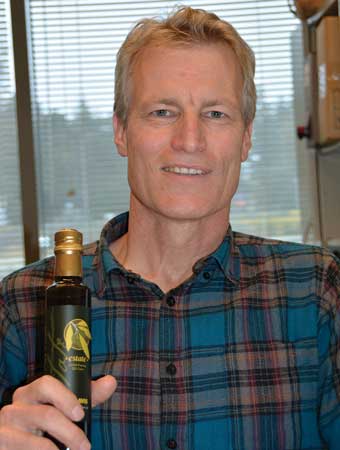 The inaugural batch of UC Davis Olive Oil in 2005 was a huge success; more than 1,000 bottles were sold in one day. Shortly thereafter, Flynn’s curiosity and entrepreneurism led him to consider ideas beyond resolving a liability issue: “I started floating the idea of doing an olive center—a research and education center—and started getting folks here on board with the idea. The Robert Mondavi Institute was interested in … seed-funding these kinds of centers that would build a better connection between the university and the food and beverage industry,” Flynn says. And thus with initial funding set at $75,000 over three years combined with revenue from bottling and selling branded olive oil, the UC Davis Olive Center was established in January 2008.
The inaugural batch of UC Davis Olive Oil in 2005 was a huge success; more than 1,000 bottles were sold in one day. Shortly thereafter, Flynn’s curiosity and entrepreneurism led him to consider ideas beyond resolving a liability issue: “I started floating the idea of doing an olive center—a research and education center—and started getting folks here on board with the idea. The Robert Mondavi Institute was interested in … seed-funding these kinds of centers that would build a better connection between the university and the food and beverage industry,” Flynn says. And thus with initial funding set at $75,000 over three years combined with revenue from bottling and selling branded olive oil, the UC Davis Olive Center was established in January 2008.
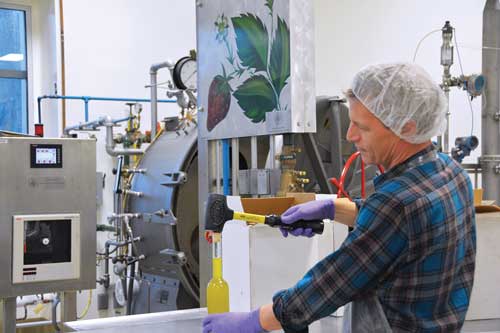 Unlike a Virgin
Unlike a Virgin
The center engages in research that benefits California’s olive industry, including best practices for the curing of table olives and processing of quality olive oil, improved strategies for the management of waste from olive mills, and studies on the health benefits of olives and olive oil. “The strength of the center really is in the faculty and research staff that are available here at UC Davis,” Flynn points out. The center unites academic researchers from the university’s various departments and disciplines, including food safety, food science, chemistry, sensory evaluation, and health. In fact, Selina Wang, the center’s research director, was teaching a course in the food science department when she became involved with the olive center’s first seminal research project. Extra virgin olive oil is considered the highest grade of olive oil around the world, so the objective of that project was to determine the quality of extra virgin olive oils in California supermarkets. “We worked two years on those supermarket samples. I was the one who drove all over California and got samples. We didn’t want to fly with the samples because we wanted to be very careful about not exposing the oils to any potentially elevated temperatures that we had no control of,” Wang says. The research culminated in the controversial yet highly publicized report “Tests Indicate That Imported ‘Extra Virgin’ Olive Oil Often Fails International and USDA Standards,” which determined that nearly 70% of extra virgin olive oils in California supermarkets were mislabeled and/or rancid. “We decided to publish the report through the olive center instead of going through a peer-reviewed journal so that we could actually name the brands,” Wang discloses. Some of the brands the report identified as mislabeled were Bertolli, Carapelli, Colavita, Rachael Ray, Pompeian, Safeway, and 365 Everyday Value.
Upon its 2010 release, the report had a significant impact: It was used as material evidence in an investigation by the U.S. International Trade Commission and class-action lawsuits against unscrupulous olive oil producers. Even now, more than five years after its issue, the report is often quoted—and misquoted—in the press. Neither Flynn nor Wang was prepared for the intense media scrutiny the report generated, but both are proud of the effect it had on California’s olive oil industry. The data from that report along with other data generated through chemical and sensory research performed at the olive center have been integral in the California Dept. of Food and Agriculture’s decision to adopt higher quality standards for olives and olive oil. “That data was important for the industry folks to convince themselves that they could hold themselves to a tougher standard,” Flynn says.
The report may also have influenced the revising of olive oil standards by the U.S. Dept. of Agriculture (USDA). The USDA’s revised standards identify five different grades of olive oil, but the two main categories are virgin olive oils and refined olive oils. Virgin olive oils are made solely by crushing olives; refined olive oils are made through an industrial process that includes heat and chemicals. For olive oil to be considered extra virgin, it must meet criteria that make up a chemical standard (e.g., a free fatty acid content of not more than 0.8 grams per 100 grams) and criteria pertaining to flavor and odor for a sensory standard. “Most people couldn’t care less about the chemistry; they’re more concerned about what it tastes like,” Flynn says. “In our research, we found that the levels of the standards … for the chemistry don’t really give you a good idea as to whether the oil is going to taste any good.”
--- PAGE BREAK ---
The sensory standard—which can be determined only by a panel of trained tasters—states that extra virgin olive oil should have more than zero fruitiness and defects equal to zero. However, most of the olive oil in the world is not evaluated by professional tasters. Moreover, these criteria are not all that difficult to meet. “Extra virgin does not mean super high quality because you can reach that sensory standard with an oil that’s not particularly fresh and not particularly great, but it’s not yet rancid. I had one miller tell me that it’s sort of like you’re getting a D: You’re passing but barely,” Flynn notes. In addition, by the time most extra virgin olive oils are purchased by U.S. consumers, they are probably either rancid or fusty. This is because olive oil is perishable, and as it gets old, it degrades in quality. “Every extra virgin olive oil will become virgin at some point because they’re all perishable. You can think of it as a continuum: extra virgin olive oil will degrade to virgin olive oil and then it will keep going bad,” Wang says, until it becomes rancid. However, it is impossible to visually distinguish fresh extra virgin olive oil from rancid olive oil, and because U.S. consumers have predominantly been buying and consuming rancid oil, they can’t taste the difference either. In fact, “44% percent of consumers prefer rancid olive oil because that’s what they think olive oil should taste or smell like,” Wang says. It is thus not surprising that the most common defect in olive oil is rancidity.
Rancid Radar
Armed with the knowledge that most of the extra virgin olive oil sold in supermarkets was rancid, Wang approached Justin Siegel, an assistant professor in the UC Davis chemistry department, about developing a biosensor to detect rancid olive oil. Siegel’s laboratory focuses on computational enzyme engineering, which is the manipulation of enzymes to determine a particular structure or function. The enzymes Siegel and his laboratory engineer can detect, mimic, remove, or change specific molecules in three categories: 1) chemicals and energy, 2) health, and 3) food. “We … discover and identify enzymes that can recognize in a complex food matrix specific molecules that you either want there or don’t want there,” Siegel says. Consequently, a team of UC Davis students advised by Siegel and Wang developed an enzyme-based electrochemical biosensor that detects the molecular compounds characteristic of rancid oil. The conventional way of detecting rancid olive oil involves performing a mass spectrometry-based assay (which requires expensive equipment and trained professionals), so the biosensor was designed to provide producers, distributors, retailers, and consumers with a simple way to evaluate the chemical profile of olive oil.
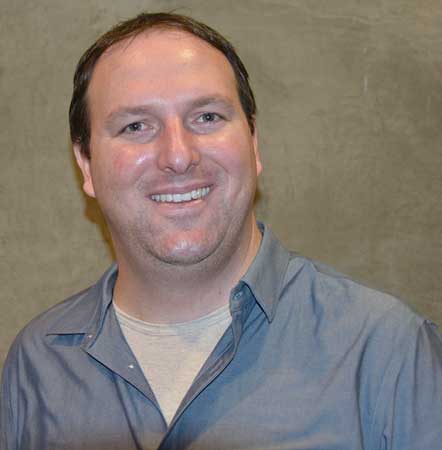 Although the biosensor won the grand prize at an international science competition, issues with funding and marketability will likely prevent commercialization at this stage. Nonetheless, Siegel is also working with the olive center on another project. “Olives are edible, but in most cases not right off the tree. So the primary objective is to remove the bitterness so that [they’re] palatable,” Flynn says. Siegel is testing an enzyme that will replace the use of a chemical agent used to debitter table olives: sodium hydroxide (lye). To produce table olives, olives are picked when they are green, cured with lye to quickly draw out the compound that makes olives bitter, and for canned black olives, artificially oxidized to turn them black. (The final step is soaking the olives in a brine or other marinade.) “The lye treatment originated at UC Davis, so we’re responsible for this,” Wang reveals. The use of lye to debitter olives generates a lot of wastewater as the fruit must be thoroughly soaked and rinsed over several days to ensure that no lye remains in the olives. “The concept there is to use enzymes to process black olives so that we don’t generate as much waste and maintain the health benefits of olives,” Siegel says.
Although the biosensor won the grand prize at an international science competition, issues with funding and marketability will likely prevent commercialization at this stage. Nonetheless, Siegel is also working with the olive center on another project. “Olives are edible, but in most cases not right off the tree. So the primary objective is to remove the bitterness so that [they’re] palatable,” Flynn says. Siegel is testing an enzyme that will replace the use of a chemical agent used to debitter table olives: sodium hydroxide (lye). To produce table olives, olives are picked when they are green, cured with lye to quickly draw out the compound that makes olives bitter, and for canned black olives, artificially oxidized to turn them black. (The final step is soaking the olives in a brine or other marinade.) “The lye treatment originated at UC Davis, so we’re responsible for this,” Wang reveals. The use of lye to debitter olives generates a lot of wastewater as the fruit must be thoroughly soaked and rinsed over several days to ensure that no lye remains in the olives. “The concept there is to use enzymes to process black olives so that we don’t generate as much waste and maintain the health benefits of olives,” Siegel says.
Olive Oil as Medicine
“Olives and olive oil have a long history of health [benefits],” Wang says, but some of the benefits attributed to olives and their juice had not been definitively substantiated. The UC Davis Olive Center recently published two reports reviewing the effect of extra virgin olive oil on clinical risk factors for chronic diseases. The reports indicate that extra virgin olive oil lowers blood pressure and decreases the risk of heart attacks, strokes, and other forms of heart disease by lowering cholesterol and triglycerides. These health benefits are attributable to the many phenolic compounds that olives and extra virgin olive oil contain. In fact, because extra virgin olive oil is minimally processed, it is the only grade of olive oil that possesses the essential phenolic compounds responsible for the fruit’s medicinal-like properties. “Nutrition studies are hard to control, but in literature, the number one health benefit on which every paper agrees is its ability to lower blood pressure,” Wang clarifies.
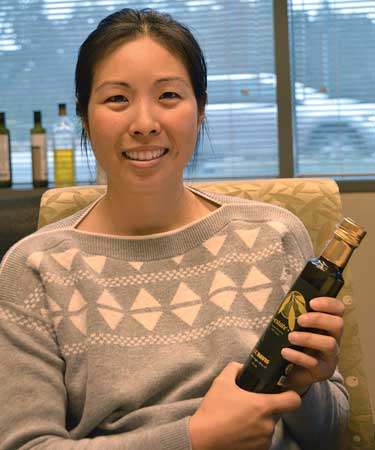 The phenolic compounds of olives also impart the characteristic bitterness and robust flavor of olives and extra virgin olive oil. “The more antioxidants an oil has, the longer it will last because it is protecting itself,” Wang adds. Accordingly, extra virgin olive oils with a high phenolic content are more flavorful, provide more medicinal benefits, and have a longer shelf life. As a consequence, the most important indicators of a quality extra virgin olive oil are taste and freshness. “What you’re looking for when you taste olive oil are fruity, bitter, and pungent. Those are the three positive attributes,” Flynn stresses. Consumers purchasing extra virgin olive oil would thus do well to taste an oil before they buy it. If tasting is not an option, a recent harvest date on the bottle is another good indicator of an olive oil’s freshness. And because extra virgin olive oil degrades over time (an opened bottle has a shelf life of three to six months), the oil should be in a dark container and kept away from heat and light.
The phenolic compounds of olives also impart the characteristic bitterness and robust flavor of olives and extra virgin olive oil. “The more antioxidants an oil has, the longer it will last because it is protecting itself,” Wang adds. Accordingly, extra virgin olive oils with a high phenolic content are more flavorful, provide more medicinal benefits, and have a longer shelf life. As a consequence, the most important indicators of a quality extra virgin olive oil are taste and freshness. “What you’re looking for when you taste olive oil are fruity, bitter, and pungent. Those are the three positive attributes,” Flynn stresses. Consumers purchasing extra virgin olive oil would thus do well to taste an oil before they buy it. If tasting is not an option, a recent harvest date on the bottle is another good indicator of an olive oil’s freshness. And because extra virgin olive oil degrades over time (an opened bottle has a shelf life of three to six months), the oil should be in a dark container and kept away from heat and light.
Thanks to the UC Davis Olive Center, everyone can appreciate and treat extra virgin olive oil like the exceptional fruit juice it is.
 A Scientist Devoted to the Whole Solution
A Scientist Devoted to the Whole Solution
While some scientists may try to dissect and study the phytochemicals in olives and olive oil that make them effective against certain chronic diseases, it may be best to appreciate them as a whole. UC Davis food science professor and nutritionist Carolyn Slupsky believes that for each health-promoting food, the whole is greater than its components. “I don’t think we really understand food. If you think about food science…, it’s always been about trying to take food apart or … concentrate certain aspects of food. But what we don’t really know or understand is how … all these different components in a particular fruit or vegetable work together in order to have health-promoting benefits,” Slupsky says. Slupsky studies how processing and agricultural practices affect food and, in turn, how food and nutrition affect metabolism, the gut microbiome, and human health.
The gut microbiome is an integral part of the human genetic landscape and helps shape metabolism throughout life. Certain nutrients from dietary foods that are essential for human life can be manufactured only through gut-dwelling microbes. “The microbiome exists to help us digest food [and] is the largest immune organ” in the body, Slupsky explains. Consequently, a healthy microbiome leads to higher immune tolerance whereas an unhealthy microbiome leads to noncommunicable chronic diseases. Dietary intake has a profound effect on gut microbes, and Slupsky believes that the Mediterranean diet, in which plant foods and extra virgin olive oil play significant roles, contains all of the components that establish and maintain a healthy microbiome. “In general, high fiber foods such as vegetables and fruits are especially important. Any sort of fiber-rich food that ends up making it past the stomach and down into the colon, where the majority of the bacteria are, is good for the microbiome,” she says.
Slupsky sees a future in which treating disease will be a matter of obtaining balanced nutrition from the right foods. “In the past however many years, there’s been a lot of stuff that’s come to light that’s actually shown us that we’ve made some really bad decisions,” Slupsky says, such as the use of trans fats and too many omega-6 fatty acids. “How do we really get down to really understanding what we need, and at what proportions do we need it? I think that the food [professionals] working together closely with nutritionists can get to the point at which we can make [better] recommendations.”
Toni Tarver is senior writer/editor of Food Technology magazine ([email protected]).
